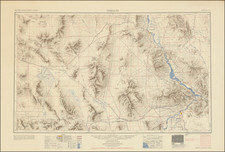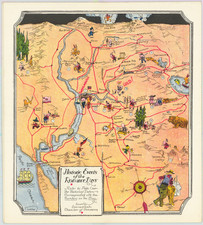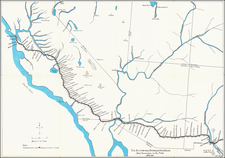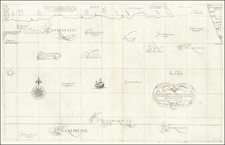Rare (virtually unobtainable) map of the Gold Regions of California, published by James Wyld in London.
The present map offers a detailed look at the California Gold Regions, extending from Mission San Gabriel and the Santa Barbara Channel in the south to Cape Mendocino and the Pyramid Lake Area, with a list of 26 California counties shown. The map is drawn from Wyld's Map of the Gold Regions of California Compiled from Original Surveys, published by Wyld in London on January 8th, 1849, a map which extends to San Diego and the Great Salt Lake and is drawn from Wilkes map of the region.
The map appeared in James Wyld's rare work, Notes on the Distribution of Gold throughout the World, including Australia, California, & Russia, published in London in 1852.
As noted by Howell: Wyld had previously published a map and guide to the California gold fields in 1849. This book, however, is a survey of gold and gold mining throughout the world, with particular emphasis on Australia and California. He concentrated on the subject of quartz mining for gold in California, a subject that was barely mentioned in the 1849 pamphlet. The map of California locates various gold-bearing quartz veins, as well as the "Mountain of Pure Sulphur" from the 1849 map.
In the present map, Wyld adds dramatically to the details of his earlier map, identifying new Silver Mines, rivers and other details in Southern California and greatly adding to the details in the Gold Mining Regions. Far more cities, roads, rivers and other geographical detail is shown in and around San Francisco and the Bay.
To the east, the Walker River System and Lake Walker have been added, along with Carson River and Lake Carson. Details of the Owens River have also been added.
As noted by Streeter:
The interest of this pamphlet lies in the attention paid to quartz mining for gold in California. This was scarcely mentioned in the Wyld 1849 pamphlet. Various gold bearing quartz veins are shown on the California map, which still shows the "Mountain of Pure Sulphur" of the 1849 Wyld map.
The larger Wyld map was published with a 32 page pamphlet entitled Geographical and Mineralogical Notes, to accompany Mr. Wyld's map of the gold regions of California.
This smaller Wyld map of the California Gold Regions and the pamphlet Distribution of Gold throughout the World, are extremely rare. We note one example of the map on the market in the past 30 years (Arkway 1988, Catalog XXXI) and no examples of the pamphlet with map in the past 30 years. The Streeter copy of the pamphlet was sold for $400 in 1969.
James Wyld Sr. (1790-1836) was a British cartographer and one of Europe’s leading mapmakers. He made many contributions to cartography, including the introduction of lithography into map printing in 1812.
William Faden, another celebrated cartographer, passed down his mapmaking business to Wyld in 1823. The quality and quantity of Faden’s maps, combined with Wyld’s considerable skill, brought Wyld great prestige.
Wyld was named geographer to Kings George IV and William IV, as well as HRH the Duke of York. In 1825, he was elected an Associate of the Institution of Civil Engineers. He was one of the founding members of the Royal Geographical Society in 1830. Also in 1830, his son, James Wyld Jr., took over his publishing house. Wyld Sr. died of overwork on October 14, 1836.
James Wyld Jr. (1812-87) was a renowned cartographer in his own right and he successfully carried on his father’s business. He gained the title of Geographer to the Queen and H.R.H. Prince Albert. Punch (1850) described him in humorous cartographic terms, “If Mr. Wyld’s brain should be ever discovered (we will be bound he has a Map of it inside his hat), we should like to have a peep at it, for we have a suspicion that the two hemispheres must be printed, varnished, and glazed, exactly like a pair of globes.”











![California [with large inset of Utah and Part of New Mexico]](https://storage.googleapis.com/raremaps/img/small/92004.jpg)


![[California] Honor Roll Foresters of America May 1, 1947 to May 1, 1948](https://storage.googleapis.com/raremaps/img/small/63016.jpg)